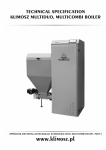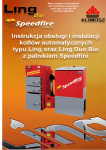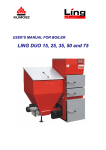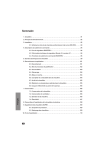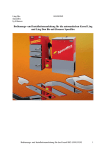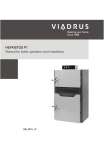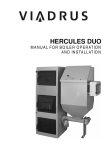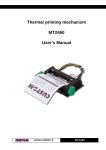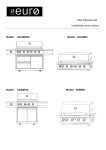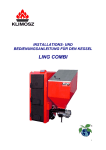Download Operation and installation manual 2013.03.06 1 o
Transcript
1o Operation and installation manual 2013.03.06 ORIGINAL MANUAL part 2/2 KLIMOSZ COMBI B boilers are supplied in parts on pallet, which provides easy transport to the boiler room. Advantages of the boiler: • Automatic, simple and quick boiler operation and maintenance; • possibility of installing an automatic pellet lighter; • possibility of burning wood and large grade coal in an extra grate; • cost-effective operation; • a low level of noxious substances in flue gas (tests in accordance with EN 303-5); 1. Technical Data for KLIMOSZ COMBI Table 1a. Dimensions and technical parameters of the KLIMOSZ COMBI boiler. Parametr kW kW % % kW kW Klimosz Combi NG 15 15 15 80 80 5,0 ÷ 15,0 5,0 ÷ 15,0 Klimosz Combi NG 20 20 20 80 78 6,0 ÷ 20,0 6,0 ÷ 20,0 Klimosz Combi NG 25 25 20 80 78 7,5 ÷ 25,0 6,0 ÷ 20,0 Klimosz Combi NG 32 32 20 81,5 82,5 9,6 ÷ 32,0 6,0 ÷ 20,0 kg/h 2,5 3,3 4,1 5,1 kg/h 3,8 5,1 5,1 4,8 dm3 230 230 230 230 days 8,5 6,0 5,0 4,0 days 4,5 3,5 3,5 3,5 g/s 14,50 15,31 17,68 20,06 g/s 14,70 16,7 16,7 13,83 °C 100 ÷ 250 100 ÷ 250 100 ÷ 250 100 ÷ 260 kg m2 dm3 mm Pa bar bar bar - 3 470 35 156 10 ÷ 15 3 490 36 156 10 ÷ 20 SI Nominal power - pea coal - pellets Efficiency - pea coal Efficiency - pellets Power regulation scope - pea coal - pellets Use of fuel at nominal power – continuous heating - pea coal 27,5 MJ/kg - pellets 18 MJ/kg Storage bin volume Approximate combustion time at nominal power - pea coal 27MJ/kg - pellets 16MJ/kg Flow of fumes in the smoke conduit - pea coal - nominal power Flow of fumes in the smoke conduit - pellets - nominal power Recommended working temperature for heating water Boiler class Mass Heating area of the boiler Water volume Diameter of fumes outlet Chimney draught Water maximal working pressure Water minimal working pressure Water maximal trial pressure Fluid group Recommended working temperature for heating water Maximal working temperature for heating water Minimal temperature of water returning to the boiler Maximal permitted level of heating material Safety valve °C 3 510 40 156 10 ÷ 20 4,0 5,9 2 – wather 65 ÷ 80 °C °C m bar Operation and installation manual part 2. 2015.06.09 3 530 50 156 10 ÷ 20 90 50 30 4,0 2 Noise level Connections of the boiler - heating and returning water Resistance of water flow through the boiler ∆t = 20oC Electric energy consumption (fan / motor) Electric energy consumption (shot light-option) Electric insulation dB < 65 (A) 2 ” or 6/4” GZ mbar 0,4 ÷ 20 W - 230V / 50 Hz 180 / 80 IP 40 Table 1b. Dimensions and technical parameters of the KLIMOSZ COMBI boiler. Parametr Nominal power - pea coal - pellets Efficiency - pea coal Efficiency - pellets Power regulation scope - pea coal - pellets Use of fuel at nominal power – continuous heating - pea coal 27,5 MJ/kg - pellets 18 MJ/kg Storage bin volume Approximate combustion time at nominal power - pea coal 27MJ/kg - pellets 16MJ/kg Flow of fumes in the smoke conduit - pea coal - nominal power Flow of fumes in the smoke conduit - pellets - nominal power Recommended working temperature for heating water Boiler class Mass Heating area of the boiler Water volume Diameter of fumes outlet Chimney draught Water maximal working pressure Water minimal working pressure Water maximal trial pressure Fluid group Recommended working temperature for heating water Maximal working temperature for heating water Minimal temperature of water returning to the boiler Maximal permitted level of heating material Safety valve Noise level Connections of the boiler - heating and returning water Resistance of water flow through the boiler ∆t = 20oC Electric energy consumption (fan / motor) Electric energy consumption (shot light-option) Electric insulation 3 kW kW % % kW kW Klimosz Combi NG 42 42 36,3 80 80 12,6 ÷ 42 10,9 ÷ 36,3 Klimosz Combi NG 49 49 43,3 80 80 14,7 ÷ 49 13 ÷ 43,3 kg/h 6,9 8,0 kg/h 9,1 10,8 dm3 230 230 days 3,0 2,5 days 2,0 1,6 g/s 24 30,3 g/s 25 28 °C 120 ÷ 260 120 ÷ 260 kg m2 dm3 mm Pa bar bar bar - 3 613 60 156 15 ÷ 20 3 630 65 156 15 ÷ 20 SI °C °C °C 2,0 3,0 2 – wather 65 ÷ 80 90 50 m bar dB 30 4,0 < 65 (A) 2 ” or 6/4” GZ mbar 0,4 ÷ 20 W - 230V / 50 Hz 250 / 80 IP 40 Operation and installation manual part 2. 2015.06.09 2. Technical Data for KLIMOSZ COMBI B Table 2. Dimensions and technical parameters of the KLIMOSZ COMBI B boiler. Parametr kW kW % % kW kW Klimosz Combi B 15 15 15 81 80 5,0 ÷ 15,0 5,0 ÷ 16,0 Klimosz Combi B 20 20 20 80 78 6,0 ÷ 20,0 6,0 ÷ 20,0 Klimosz Combi B 32 32 20 81,5 82,5 9,6 ÷ 32 6,0 ÷ 20,0 Klimosz Combi B 35 35 25 81 81 10,5 ÷ 35 7,5 ÷ 25 kg/h 2,5 3,3 5,1 5,7 kg/h 3,8 5,1 4,8 6,4 dm3 230 230 230 230 dni 8,0 6,5 4,0 3,5 dni 4,5 3,5 3,5 3 g/s 11,2 15,31 17,68 18,9 g/s 12,4 16,7 16,7 18,1 °C 100 ÷ 250 100 ÷ 260 100 ÷ 260 100 ÷ 260 kg m2 dm3 mm Pa bar bar bar - 3 460 31 156 10 ÷ 15 3 475 40 156 10 ÷ 20 3 490 50 156 10 ÷ 20 525 60 156 15 ÷ 20 SI Nominal power - pea coal - pellets Efficiency - pea coal Efficiency - pellets Power regulation scope - pea coal - pellets Use of fuel at nominal power – continuous heating - pea coal 27,5 MJ/kg - pellets 18 MJ/kg Storage bin volume Approximate combustion time at nominal power - pea coal 27MJ/kg - pellets 16MJ/kg Flow of fumes in the smoke conduit - pea coal - nominal power Flow of fumes in the smoke conduit - pellets - nominal power Recommended working temperature for heating water Boiler class Mass Heating area of the boiler Water volume Diameter of fumes outlet Chimney draught Water maximal working pressure Water minimal working pressure Water maximal trial pressure Fluid group Recommended working temperature for heating water Maximal working temperature for heating water Minimal temperature of water returning to the boiler Maximal permitted level of heating material Safety valve Noise level Connections of the boiler - heating and returning water Resistance of water flow through the boiler ∆t = 20oC Electric energy consumption (fan / motor) Electric energy consumption (shot light-option) Electric insulation °C 4,0 8,0 2 – woda 65 ÷ 80 °C 90 50 °C m bar dB 30 4,0 < 65 (A) 2 ” lub 6/4” GZ mbar 0,4 ÷ 20 W - 230V / 50 Hz 180 / 80 IP 40 Operation and installation manual part 2. 2015.06.09 4 • Fuel parameters: • calorific value Qir > 15MJ / kg ; • • ash content A r < 12% ; moisture content coal pellets W r < 15% , wood W r < 20% ; • • • • volatile matter content V r > 28% ; ash fusion point t A > 1200 o C ; caking properties RI < 20 (max 30); low swelling ATTENTION!!! The KLIMOSZ heating boilers are not intended for burning waste and no substances other than those recommended by the manufacturer can be burnt in them. Table 3. Recommended fuel for burning in automatic mode. Main fuel Fuel type Hard coal pea grade coal Substitute fuel Biomass Granulation [mm] Gr II 8 ÷ 20 (max 30) Calorific value [MJ/kg] Fuel type Granulation [mm] Calorific value [MJ/kg] pellets ** Φ6÷8 16 ÷ 18 24 ÷ 28 * *) Non-caking, non-coking **) Sawdust granulate (pellets) should be at least hard enough for it to be impossible to crush a few fuel granules in a clenched fist, preventing the feeder from getting jammed. Light colour grades are recommended, without bark, which can cause deposit formation in the burner. Table 4. Recommended fuel for burning in manual mode (emergency combustion chamber of the KLIMOSZ COMBI and KLIMOSZ COMBI B boiler). Fuel Unit Size non-coking, non-caking hard coal Wood (mm) 200 O I [40 ÷ 80]; Ko II [63 ÷ 125] ATTENTION!!! MOISTURE CONTENT IN FUEL MUST NOT EXCEED 15%. USING MOIST FUEL RESULTS IN A CONSIDERABLE REDUCTION IN THE BOILER'S POWER CAPACITY (EVEN BY AS MUCH AS 50%) AND REDUCTION IN THE LIFE-SPAN OF THOSE PARTS OF THE BOILER WHICH ARE IN CONTACT WITH MOIST FUEL. USING IMPROPER QUALITY OR MOIST FUEL RESULTS IN LOSING WARRANTY RIGHTS WITH RESPECT TO THE PARTS EXPOSED TO CONTACT WITH SUCH FUEL. 3. Construction of the KLIMOSZ COMBI, KLIMOSZ COMBI B boiler The KLIMOSZ COMBI and KLIMOSZ COMBI B automatic boiler is not maintenance-free; it is therefore recommended that the user should carefully read the principles of its operation, regulation and maintenance in order to avoid any problems related to its work. Construction of the KLIMOSZ COMBI boiler makes it possible to use solid fuels in the automatic or traditional mode as well as to use liquid fuels. The boiler has been constructed on the base of a cast-iron exchanger of the multi-purpose VIADRUS U22 boiler. The castiron part of the boiler, which is called the upper combustion chamber, can be used for burning coal, coke or wood as substitute fuel after manual fuel loading. KLIMOSZ COMBI boilers can be installed in a closed system up to working pressure 4,0 bar. Under the water grate of the boiler heat exchanger of a U22 boiler, there is an added steel combustion chamber, with (W version) or without (S version) a water jacket. There are the following cast-iron parts in the 5 Operation and installation manual part 2. 2015.06.09 lower combustion chamber: a round grate, a round deflector above the grate, an elbow or retort, and a steel chamber of the air mixer. Fuel burning (pea grade coal, pellets) in automatic mode takes place in the lower chamber. Inside the fuel feeding retort there are holes which regulate the pressure of air needed for burning, which prevents flames from reaching the fuel feeder during the burning process. Under the combustion chamber there is an ash pan. Next to the boiler, there is a fuel storage bin with a feeder screw at the bottom. The ash pan capacity is suited to the capacity of the fuel bin, i.e. the ash pan should be filled with ash after the entire fuel from the bin has been burnt. There is a water tank behind the fuel bin for emergency extinguishing (when pea grade coal is used as fuel) or a place for installing a thermostatic valve (required when pellets are used as fuel) – a protective device in case flame gets to the fuel bin. The fan which supplies air for combustion is situated before the fuel bin and is connected to the mixer. The amount of air is controlled electronically by the boiler regulator. The inlet and outlet of heating water is situated at the back part of the boiler. At the back of the boiler there is a smoke conduit, which carries flue gas to the chimney. The exchanger is insulated with mineral wool, which reduces heat loss during combustion. The steel casing is protected with high quality powder paint. 3.1 Hand-fired furnace of the KLIMOSZ COMBI and KLIMOSZ COMBI B boiler The KLIMOSZ COMBI and KLIMOSZ COMBI B boiler provides the possibility for burning solid fuels in the traditional mode. After manual loading, wood and coal, as substitute fuel, can be burnt in the upper part of the exchanger, called the "upper combustion chamber". The upper combustion chamber is an emergency chamber, in which burning throughout the heating season is not recommended due to the lower power capacity achieved as compared to the maximum power capacity of the boiler. For burning in the upper chamber to run properly, some conditions for chimney draught have to be met. Operation and installation manual part 2. 2015.06.09 6 4. Boiler dimensions Fig. 1. Dimensions boilers KLIMOSZ COMBI NG. T Y P S L H S1 S2 L1 L2 L3 H1 H2 Z1 Z2 P1 P2 U1 U2 [mm] [mm] [mm] [mm] [mm] [mm] [mm] [mm] [mm] [mm] [mm] [mm] [mm] [mm] [mm] [mm] 15 1180 795 1555 550 600 630 30 710 1150 1271 250 275 630 275 430 180 20 1180 795 1555 550 600 725 82 710 1150 1271 250 275 630 275 - - 25 1180 795 1555 550 600 725 82 710 1150 1271 250 275 450 275 430 180 32 1180 900 1555 550 600 822 82 710 1150 1271 250 275 450 275 430 180 42 1180 996 1555 600 610 918 95 710 1150 1271 100 100 65 290 50 100 49 1180 1092 1555 600 610 1014 95 710 1150 1271 290 290 65 290 50 100 7 Operation and installation manual part 2. 2015.06.09 Fig. 2. Dimensions boilers KLIMOSZ COMBI B. S L H S1 S2 L1 L2 L3 H1 H2 Z1 Z2 P1 P1 [mm] [mm] [mm] [mm] [mm] [mm] [mm] [mm] [mm] [mm] [mm] [mm] [mm] [mm] 15 1200 655 1410 550 600 470 185 745 1150 1300 95 272 450 275 20 1200 765 1410 550 600 580 185 745 1150 1300 95 272 450 275 32 1200 860 1410 550 600 728 185 745 1150 1300 95 272 450 275 35 1200 950 1410 550 600 813 185 745 1150 1300 95 272 450 275 Operation and installation manual part 2. 2015.06.09 8 COMBI 15 COMBI B 15 COMBI 20 COMBI B 20 COMBI 25 COMBI 32 COMBI B 32 COMBI 42 COMBI B 35 COMBI 49 A B C Combustion chamber [mm] [mm] [mm] [dm3] 410 230 350 33 410 340 350 48,8 410 340 350 48,8 410 435 350 51,7 410 530 350 76,1 410 625 350 89,7 Fig. 3. Dimensions of the additional combustion chamber. 5. Boiler description Fig. 4. Description of the KLIMOSZ COMBI and KLIMOSZ COMBI B boilers. 1. Flue gas thermometer (optional); 2. Boiler controller; 3. Boiler cleaning hole; 4. Storage bin; 5. Chamotte plate; 6. Upper combustion chamber; 7. Inspection hole with the fire grate; 8. Cast- iron deflector. 9. Storage bin cleaning hole; 10. Retort burner; 11. Measuring hole of feeding pipe ; 12. Fan; 13. Ashpan; 14. Boiler feet. 9 Operation and installation manual part 2. 2015.06.09 NOTE No alterations in the furnace chamber may be made which could negatively affect the life-span of the boiler or flue gas emission. 1: Fan connector 2: Air mixer 3: Retort grate 4: Screw feeding channel 5: Anti-smoke holes 6: Retort elbow Fig. 5. Schematic diagram of a retort furnace in coal burning. 5.1 Delivery and installation KLIMOSZ COMBI B boilers KLIMOSZ COMBI B boilers are supplied in parts on pallet, which provides easy transport to the boiler room. On the pallet is: cast-iron VIADRUS U22 boiler (1), Steel base with a retort burner (2), feeding tube (3), motoreducer (6), feeding screw (5), feet (4), fan (7), storage bin (8), controller (to order), chamotte plate, set of screw. Fig. 6. KLIMOSZ COMBI B boiler components. 5.2 Boiler accessories Operation and installation manual part 2. 2015.06.09 10 Standard: On request: • regulator of boiler; • Installation and Operation Manual part 1; • Installation and Operation Manual part 2; • emergency extinguishing tank – “fire fighter” for KLIMOSZ COMBI B. • Regulator Operation Manual; • paraffin fuse - 1 item for KLIMOSZ • screws - hardness class 8.8 (as cotter pins of the COMBI B; feeder screw) - 2 items; • cast-iron deflector above the burner of the • room thermostat; KLIMOSZ COMBI boiler - 1 item; • manual 4-way mixer (e.g. ESBE); • chamotte plates in the upper furnace in • mixer actuator (e.g. ESBE); KLIMOSZ COMBI, KLIMOSZ COMBI B (see table Number of chamotte plates in the Klimosz • domestic water heater (e.g. DRAŹICE); Combi boiler); • automatic pellet lighter (up to 35 kW); • protective plate (covers the retort burner when the • flue gas temperature sensor (option aimed to upper combustion chamber is used) 15 ÷ 49 kW– activate the information that it is necessary to 1 item; clean the boiler). • emergency extinguishing tank – “fire fighter” only in KLIMOSZ COMBI. • paraffin fuse - 1 item only in KLIMOSZ COMBI; Required when biomass is used as fuel: • protecting valve, e.g. STS Watts (instead of the "fire fighter”)- required for all boilers 55 ÷ 75 kW; • limit switch of the storage bin. 6. Installation of the fire-resistant catalyst ATTENTION! The boiler must not be operated without deflector in the retort furnace, as it leads to accelerated depositing of soot on the boiler due to incomplete burning, and to quicker wearing of the boiler’s steel parts. Table 5. Number of catalysts (chamotte) in a KLIMOSZ COMBI and KLIMOSZ COMBI B boiler. 11 Boiler Plate [mm] KLIMOSZ COMBI, COMBI B Klimosz Combi NG 15, Combi B 15 Klimosz Combi NG 20, Combi B 20 Klimosz Combi NG 25 Klimosz Combi NG 32, Combi B 32 Klimosz Combi NG 42, Combi B 35 Klimosz Combi NG 49 Chamotte plate 2 pc. 3 pc. 3 pc. 4 pc. 5 pc. 6 pc. Operation and installation manual part 2. 2015.06.09 Fig. 8. Position of ceramic catalyst on the exchanger shelves in a KLIMOSZ COMBI and KLIMOSZ COMBI B boiler. 7. Checking the leak-tightness of the grate In order to achieve complete burning of fuel in the grate, it is important to maintain leak-tightness between the grate and the retort burner and absence of any blocking of the nozzles which supply air flow as well as the cleanliness of the mixer. It may be necessary to seal the grate and clean the burner when: - fuel does not burn completely in the grate and incompletely burnt fuel is removed to the ash pan; - the heat exchanging area of the heat exchanger gets soiled quicker than usual; - the flame is short and irregular when the boiler is being heated up; - fuel burns unevenly in the burner grate. NOTE: The burner grate should be fixed such that a false draught should not leak out from under it. It should be fixed tightly, with no possibility of turning. Burner maintenance procedure: Remove the cast-iron ring to seal the grate. The grate surface on which sealing will be applied should be cleaned thoroughly to ensure good contact of the material with the sealing. The parts should be sealed with fireplace silicon with a working temperature of greater than 1200oC, which should be applied evenly around the grate perimeter. Put the grate with silicon slowly onto the other part of the burner. Another obligatory action is to clean the mixer of any impurities which may have got there during the installation or dismantling of the grate. 8. Notes about hand-firing the fuel in the upper combustion chamber 8.1 Types of fuel Klimosz boilers are equipped with another emergency combustion chamber, which is used mainly for the occasional burning of solid unsorted fuels. Wood used as fuel should not have more than a 20% moisture content. The recommended fuel is wood, wooden waste, non-caking briquettes with granulation of 30 to 80 mm. When lighting a fire in a boiler and when the chimney is cold, it is recommended that the chimney should be heated up with wooden firelighter. After the boiler has been lit, and when some fuel has been burnt, the embers in the grate should be stirred. The procedure should be interrupted when glowing fuel drops to the ash pan. The operation is performed with a hook through the door of the upper combustion chamber. After completing the Operation and installation manual part 2. 2015.06.09 12 procedure, top up the fuel without extinguishing the boiler. Fuel can be added only when the blow-in fan is switched off. Larger unburnt pieces of fuel from the ash pan can be thrown back into the furnace. Air inflow for combustion is regulated with a controller which regulates the fan operation and/or by a flap on the fan. In prolonged hand-firing, it is recommended that all the fuel (pea grade coal or pellets) should be removed from the fuel bin, feeding screw pipe and the retort burner. In this case, the protective plate should also cover the retort burner hole. This prevents soiling of the retort burner. 8.2 Lighting the boiler The boiler may be operated only by adults, who know the principles of its operation, and who follow this Operation Manual. The following should be done before the boiler is lit: • check whether there is enough water in the central heating and domestic water systems; • check whether the grate, ash pan and flue conduits are clean; • remove the ceramic catalysts from the retort furnace chamber; • put the protective plate on the retort burner (this prevents lighting the fuel in the retort burner as a result of embers falling down from the upper grate to the ash pan); • when burning in the upper chamber in the hand-firing mode, remove fuel from the retort in order to properly supply air for combustion. When burning is continued for more than two weeks, fuel should also be removed from the bin; • switch on the hand-firing mode – “hand firing” in the burning type options on the regulator. Put firelighter (paper) and wood through the charging door over the entire grate area. Light the firelighter through the door of the combustion chamber. Close the door and open slightly the ash pan door, providing air supply to the combustion chamber. Put a layer of fuel onto the burning wood. After lighting the fire, switch the regulator to the hand-fire mode, set the desired temperature and close the ash pan door. When the fuel is burning well, stoke the fire by putting in another portion of fuel (switch off the blow-in fan on the regulator when loading in fuel) Attention!!! No flammable liquids can be used and the boiler cannot be overheated when lighting the fire. No flammable materials can be left near the boiler. 8.3 Boiler operation Fuel should be topped up as needed and in accordance with the intensity of burning. Fuel should be added evenly so that it does not form a pyramid. Ash and slag should be removed from the grate only when it starts to hinder combustion. The procedure should be interrupted when, during the grate cleaning with a hook, embers start to fall down to the ash pan. In the evening, before burning in the boiler during the night, the grate should be cleaned thoroughly. In the morning, after night burning, remove caked coal with a hook to clear the air supply. Put some fuel onto the embers and do not remove ash and caked fuel from the grate until the fuel is burning. Then add fuel until the combustion chamber is full. Each time you check the amount of fuel in the combustion chamber and each time before stoking the fire, switch off the fan on the regulator (preferably by switching off the regulator) and delay opening the loading door until the fan stops; the door is leak-tight and you should first loosen it slightly, wait until pressure in the combustion chamber equalises and only then can you open the door fully. This will prevent hot flue gas from being blown out into the boiler room. The lower door of the furnace, the door of the lower combustion chamber and the loading door must be tightly closed during the boiler operation. NOTE: When opening any of the boiler's doors, stand in such a way as to prevent any hot gas from the boiler from causing harm to you or to anyone standing nearby. 13 Operation and installation manual part 2. 2015.06.09 Adding more fuel – switch off the fan first (preferably by switching off the regulator). After the fan is switched off and stopped, open the lower door of the boiler. Open the upper door of the boiler after a while, unsealing it first, and put in a layer of fuel. After the upper and lower door is closed, switch on the fan by pressing the button (as above). The boiler is now in normal operation mode. Do not add too much fuel as it may cause the boiler to overheat quickly and it negatively affects the boiler's parameters as well as the parameters of emission of hazardous substances in flue gas. 8.4 Boiler maintenance Remove ash to non-flammable, closed containers with increased resistance to corrosion (for example zincplated). The boiler can be cleaned only after it has been extinguished and cooled down!!! Cleaning the walls of the upper combustion chamber can be easily done through the open upper door. Cleaning the smoke conduits is done through the inspection hatch under the casing (the same as cleaning in automatic mode). The boiler can be cleaned with the cleaning tools supplied with it. A boiler that has been soiled with tarry substances should be cleaned in two steps. First, tarry deposits should be burnt out with suitable agents (for example Sadpal), and then the heat exchange areas should be cleaned with a brush. Cleaning semi-liquid tarry deposits results in damage to the brush and is ineffective, resulting only in spreading the tar over the boiler surface. After the boiler surface and smoke conduits have been cleaned, close the inspection hatch tightly. NOTE: Avoid accumulation of tarry deposits and soot on the heat exchanger areas and in smoke conduits. This reduces the boiler’s efficiency and poses a serious hazard of soot and tar ignition in the chimney duct, which usually results in damaging the chimney and even the building walls and in fire. Take care to make the boiler leak-tight (combustion chamber door, ash pan door, mixer cleaning hole, fuel bin cover, etc.) in order to avoid flue gas being expelled from the boiler into the boiler room. If the boiler is not in use for more than 2 days (for example, after the heating season), it must be cleaned and the fuel bin and the fuel feeding system emptied of fuel. Leave the boiler with the doors and inspection hatch covers open to enable its ventilation and to avoid moisture condensation on the steel surfaces of the boiler. Operation and installation manual part 2. 2015.06.09 14















